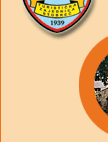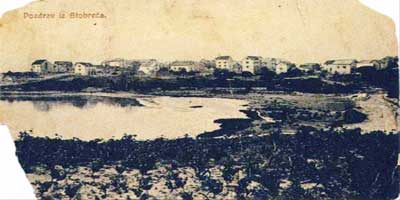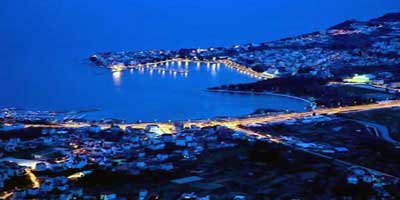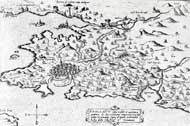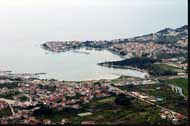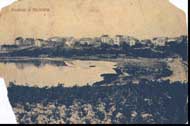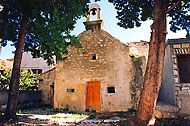Once a man of Stobreč, always man of Stobreč
Historical development
Construction heritage
The Stobreč today
In the third century BC Greek colonists from the island Issa
(Vis) established a settlement Epetion on the easily defendable
semi island surrounded by cliffs. Embraced by Mosor and Perun from
the sea, its saltiness dissolved by the river Žrnovnica, is where
the ancient Epetion settled and it's descendent Stobreč, a town
rich in gastronomy and recreational offer, only seven km away from
the Diocletian Palace.
Written by: Ante MEKINIĆ
Embraced by Mosor and Perun from the sea, its
saltiness dissolved by the river Žrnovnica, in the shell like blueness
of the furthest south east end of the peninsula of Split, lays the
ancient Epetion and its descendent - Stobreč. Raised on an ellipsoid
cliff of 4,5 ha area, visually dominating a larger bay, the ancient
Epetion is one of the oldest urban complexes on the east side of
the Adriatic. Because of its natural diversity, today’s Stobreč
is a kind of exposed establishment in a landscape which in its proportions,
structure of facilities and structural elements, meaningfully contributes
to the landscape. The wider area of Stobreč, with its favorable
microclimatic and other natural conditions, has for a long time
accounted for an Areal of exquisite value.
Historical development
Ancient writer Polibius states that Illyrian Delmats were often
known to attack Greek towns including Epetion, after them came the
Romans, three centuries after the establishment of Epetion, they
reinstated their dominance over the entire area of the east Adriatic.
With the arrival of the Romans, Greek Issa loses its role and the
centre of life becomes Salona, the center of great province Dalmatia.
The Greek Epetion becomes the roman Epetium,
without its municipal autonomy as it was situated near Salona, and
so its territory enters the constitution of the Salonitan ager.
Within the Salonitan colony, Epetium receives the status of the
ager prefecture, according to which the town provides clerks who
rule the Epetium as their town’s community. The importance of the
Roman Epetium was also in its good harbor, traffic connections and
the rich agricultural hinterland.
About the role of harbor in Stobreč in Roman times says the information
that in the known Tabula Peuntingeriani, which represents the medieval
copy of the Authentic ancient map, a greater graphical importance
is given to Eprtium than to Salona itself (on the Tabula Peuntingeriani
Portus Epetius is marked, and by the name Epetio three towers are
marked, while Salona is marked with only two).
The harbor stretched all the way from the delta of river Žrnovnica
(by the Lady of Sita church there were findings of iron rings that
were used for docking ships), and in some inscriptions that were
found the associations of transport workers were mentioned (collegium
saccarium) which obviously states the activity of the harbor in
those days.
Agricultural role of Epetium was based on the fertile field north
of the establishment and accidental archeological findings prove
that around Stobreč existed Roman economical buildings and necropolis
which indicates to the intensive development of that area in Roman
times. The delta of river Žrnovnica was full of fish and wildlife,
and especially favorable to the production or the picking of to
the production or the picking of, very important for the trade,
salt, witnessed by, even today’s, toponyms of some areas of Stobreč
like Slanice (salty) and Soline (salt).
The meaning of Salona in the first centuries of Christianity reflected
to the life in Epetium where the Salonitan martyr Felix was situated,
according to tradition he was buried in Vrbovnik near Stobreč. The
great old Christian basilica built in fifth and sixth century in
place of an earlier ancient cult building, is the most important
trace of that period in today’s Stobreč.
The incursion of Avars and Slavs, which brought Salona down, probably
did not spare Epetium either. After almost a thousand years of development
life of a town came to an end, it was later replaced by a rural
establishment Stobreč, which is named after a church St Lawrence,
adapted on the remains of an old Christian basilica. Even though
the church is dedicated to Lady of Carmel, in the historical sources
it is mentioned under the name of a roman martyr Lawrence (Lovrenco,
Lovre, etymological work by Don F. Bulić).
Data of Stobreč in the period of autonomous commune of Split were
very scarce. The establishment obviously loses its importance in
relation to other establishments of the wider Split area. During
the period of the 400 years of Venetian authority the data on Stobreč
is still very scarce. On the area where ancient town used to be
a small establishment still exists, mentioned by the graphical sources
(map by Calergi from seventeenth century).
In the beginning of the sixteenth century the
area of Stobreč is exposed to Turkish attacks even though during
the reinstatement of the Turkish-Venetian border in 1537, Stobreč
stayed within Venetian property. On the 5th June 1807 the wider
area of Stobreč was the scene of battle which ended the Napoleons
run for Dalmatia with the defeat of democracy of Poljica against
the French imperialism. In the last two centuries Stobreč gradually
loses its importance in relation to other historical entities of
the urban Split area.
Construction
heritage
Even though the present Stobreč has long outgrown its semi island
origin, it has not given up on the rich construction heritage. Therefore
the remains of the ancient fortification wall preserved on the north
side of the peninsula core are visible even today. This wall was
mentioned also by Alberto Fortis in his work ‘‘Viaggio in Dalmazia’’,
comparing them with the similar in Salona. Near this wall there
was a canal 0,35 m high and 0,62 m wide, with walls made of small
rock block, stretching along the entire peninsula all the way to
the sea. It is most probable that this canal had a function of a
city sewage system, which also witnesses to the urban life of this
town dating back to the ancient times. The peninsula core is even
today decorated by the complex of the extraordinary important national
architecture of rural typology and way of construction.
Still, the great old Christian basilica from
the fifth century with its characteristic three-nave church shape
with an in scripted apses and narthex on the west side, is the most
important historical - architectural monument in the entire establishment,
preserved in some parts and up to 7 meters high. The complex of
the old Christian church St Lawrence, the Lady of Carmel today,
shows the remains from different phases. To the oldest the walls
belong to an ancient building, probably a temple, which directs
to continuity of a cult centre in the south east part of establishment.
The early medieval little church, adapted in the apses of an old
Christian basilica, is and interesting example of overbuilding the
early architecture that characterizes the old Croatian period. Connected
to the old Croatian phase is also the Benedict abbey.
The
Stobreč today
The Stobreč today with its 4.000 inhabitants is an administrative
part of Split, distanced only seven km from the Diocletian Palace.
Leaning upon the city and town itself, Stobreč offers many possibilities
for divers and enjoyable tourist stay.
Well known beaches of Stobreč, from the sandy in the very centre
of town to the rocky ones on the south-west, attract families with
children as well as the romantics, Within reach is a safe mooring
with the appropriate infrastructure for all kinds of tourist boats.
Traditionally rich and diverse offer in gastronomy is followed by
the appropriate accommodation and hotels.
Especially great possibilities are in sport recreations: from long
walks by the sea to tennis fields, golf, bowling, basketball, handball
and soccer. Shooters have at their disposal a shooting-ground for
hunting and small caliber weapons, and those who enjoy the sea have
excellent conditions for sailing, rowing, surfing or fishing. And
for all others, who praise the sea but stick to the ground, there
is volleyball, soccer and other kinds of entertainment. The cultural
entertainment is mainly based on the rich program of Summer in Split.
However, Stobreč has its authentic national fiestas; they culminate
in August by the marking of fiesta St Lawrence, the heavenly patron
of the town.
Besides that, the tourist board of Stobreč offers also numerous
possibilities of excursions, from cruises to the near by islands
to excursions into the hinterland. Besides all natural, cultural-historical,
gastronomic, entertaining and recreational-sporting facilities,
the long tradition of organized tourism of Stobreč guarantees you
that once you arrive to Stobreč you became a man of Stobreč
forever!
|


